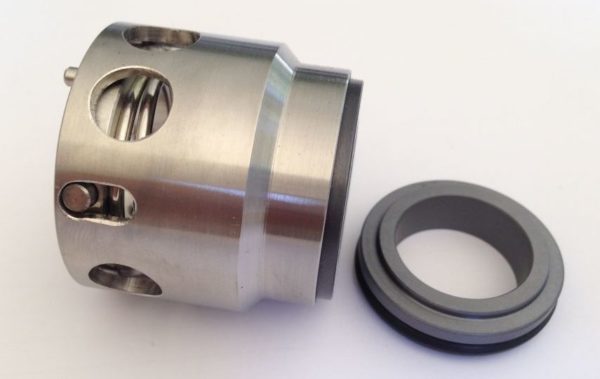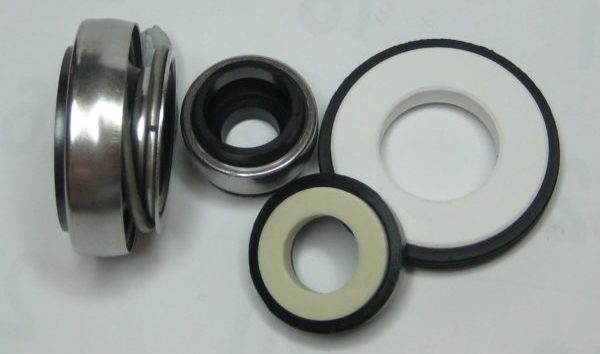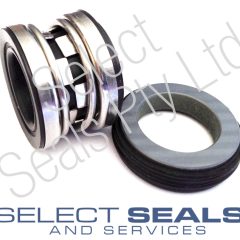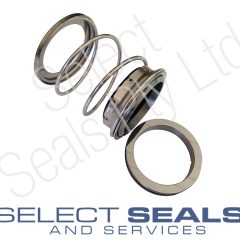Mechanical Seals Can Save You Money


ITT Lowara VS Pump Mechanical Shaft Seal
Silicon vs Silicon Carbide
IN MECHANICAL seals main friction happens in the axial direction, between faces (seal rings) lapped to a high precision. Wear is compensated in axial direction by springs or bellows.
Many mechanical seals do not wear shaft at all. Contact pressure and thus the friction force is kept to a minimum by a balanced design.
Mechanical Seals Have A Big Impact

Lowara Pump Seal
Fits PKM 160-0
MECHANICAL SEALS are mechanical devices to prevent the leakage in products through a pair or several vertical axis affecting on the end face.
They are functioned to maintain the joint under the action by the fluid pressure or magnetic influence. We can infer the advantages of the mechanical seal from the compare to other sealing accessories.
Within the reliable performance, long time service, low power consumption and small amount of disclosure, mechanical seals rise to be outstanding among other choices. Furthermore, it need not be maintained frequently.
It is designed to be applicable for the working environments of high-temperature, low temperature, high pressure, vacuum, high-speed and a variety of strong corrosive medium in the production automobile process. On most occasions, mechanical seals work with the help of a rotating shaft. Mechanical seals generally include the types of induction sealing, adhesive and sealants and flange gaskets.
End face mechanical seals, also referred to as a mechanical face seal but usually simply as a mechanical seal, is a type of seal utilised in rotating equipment, such as pumps and compressors. When a pump operates, the liquid could leak out of the pump between the rotating shaft and the stationary pump casing. Since the shaft rotates, preventing this leakage can be difficult. Earlier pump models used mechanical packing to seal the shaft. Since World War II, mechanical seals have replaced packing in many applications.
Induction sealing is the so-called cap sealing. It is a kind of mechanical seals which adapts a non-contact heating method. When the container is filled with the material, the sealing would transpire. It is mostly used to the use of a foil hermetic to the container. The foil is either reeled or pre-cut and is placed and pressed down to the material. Thus, the induction process bonds the seal to the container.
For prolonged operation in the downhole environment, it is necessary to seal various internal components of the pumping system from corrosive well fluids and debris. Although there are a variety of components within the pumping system that are susceptible to unwanted fluid migration, moving parts, such as rotating shafts, are particularly difficult to seal. To prevent fluid leaks around rotating shafts, designers often employ mechanical seals that fit around the outer circumference of a cylindrical shaft.
Mechanical seals are by a pair of or several of the vertical axis relative sliding of the end for the fluid pressure and stretch compensation mechanism to maintain the role of consolidation accompanied by supporting sealing affixed to achieve leakage resistance seal device.
Mechanical seals are generally classified into two main categories: “Pusher” or “Non-Pusher”. These distinctions refer to whether or not the secondary seal to the shaft/sleeve is dynamic or stationary. Pusher seals will employ a dynamic secondary seal (typically an o-ring) which moves axially with the primary seal face. Non-pusher seals will employ a static secondary seal (either an o-ring, high temperature graphite packing, or elastomeric bellows). In this case, the face tracking is independent of the secondary seal which is always static against the shaft/sleeve.
All mechanical seals must contain the four elements described above but the way those functional elements are arranged may be quite varied. The standards of modern mechanical seals are widely defined by API Standard 682 – Shaft Sealing Systems for Centrifugal and Rotary Pumps.
A channel is a rotating ring and stationary ring seal affixed to each other relative sliding cooperation with the dynamic seal, mechanical seals device which is the main seal, mechanical seals performance and determining the key to life. Therefore, the processing requirements of the seal faces were very high, between the seal faces in order to maintain the necessary lubrication film, must be strictly system-side cavity surface pressure per unit area, the pressure is too large and difficult to form a stable lubricating film, will accelerate the end wear; pressure is too small, increase of leakage. Therefore, to obtain good sealing performance and a sufficient life, in the design and installation of mechanical seals, we must ensure that the pressure face value per unit area in the most appropriate range.
An end face mechanical seal, also referred to as a mechanical face seal but usually simply as mechanical seals, are a type of seal utilised in rotating equipment, such as pumps, mixers, blowers, and compressors. When a pump operates, the liquid could leak out of the pump between the rotating shaft and the stationary pump casing. Since the shaft rotates, preventing this leakage can be difficult. Earlier pump models used mechanical packing (otherwise known as Gland Packing) to seal the shaft. Since World War II, mechanical seals have replaced packing in many applications.


